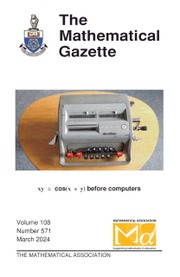No CrossRef data available.
Article contents
A kaleidoscope of solutions for a Diophantine system
Published online by Cambridge University Press: 23 January 2015
Extract
A classical exercise in recreational mathematics is to find Pythagorean triples such that the legs are consecutive integers. It is equivalent to solve the Pell equation with k = 2. In this case it provides all the solutions (see [1] for details). But to obtain all the solutions of a Diophantine system in one stroke is rather exceptional. Actually this note will show that the analogous problem of finding four integers A, B, C and D such that
with k = 2. In this case it provides all the solutions (see [1] for details). But to obtain all the solutions of a Diophantine system in one stroke is rather exceptional. Actually this note will show that the analogous problem of finding four integers A, B, C and D such that

- Type
- Articles
- Information
- Copyright
- Copyright © The Mathematical Association 2010


